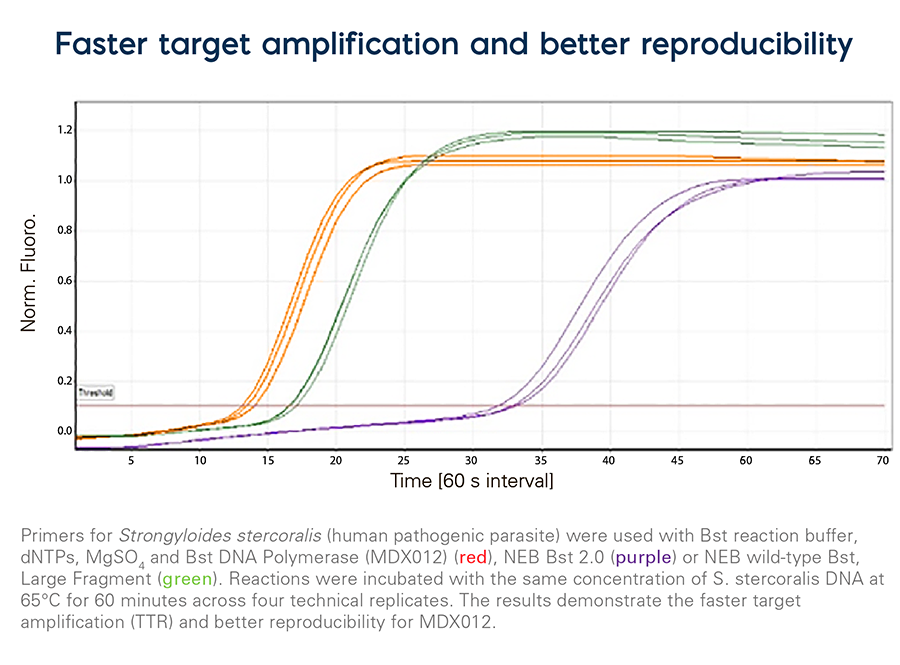Bst DNA Polymerase
Bst DNA Polymerase is an enzyme derived from the large fragment of Bacillus stearothermophilus DNA Polymerase I. It contains 5´- 3´ DNA polymerase activity and strong strand displacement activity but lacks 5´- 3´ exonuclease activity. The strong strand displacement activity enables Bst DNA Polymerase to synthesize DNA at a constant temperature making it an ideal enzyme for isothermal amplification, including HDA, MCA, and Loop-Mediated Isothermal DNA Amplification (LAMP).
Have questions about a product?
Contact us to learn more about Meridian’s molecular or immunoassay reagent portfolio. We want to hear from you!

Bst DNA Polymerase, MDX012
DNA polymerase (exo-), with strand-displacement properties. used for Isothermal DNA amplification such as LAMP (Loop-mediated Isothermal Amplification).
Documents & Resources
Description
Bst DNA Polymerase (8 U/µL) is supplied with an Enzyme Dilution Buffer and a Bst Reaction Buffer formulated to deliver the fastest amplification speed (time-to-results), yield, salt tolerance, and sensitivity, speeding up your product development time and allowing you to commercialize your new products faster. For the most difficult templates, an Inhibitor-Tolerant Bst Buffer is available that is specifically designed for high performance when using crude samples such as sputum or saliva.
Specifications
| Description | DNA polymerase (exonuclease minus), with strand-displacement properties. Bst DNA Polymerase is used for Isothermal DNA amplification and LAMP (Loop-mediated Isothermal Amplification). |
| Concentration | 10 units/µL +/-10% measured against a standard |
| Appearance | Clear, colorless solution |
| Application | Loop-mediated isothermal amplification |
| Sample type | cDNA, DNA |
| Presentation | 3 vials |
| Storage | -20 °C |
| Stability | See outer label |
| Consistency | ± 0.5 Ct variance between test and reference sample |
| DNase/RNase Contamination | No detectable degradation |
Catalogs & Brochures
Bst DNA PolymeraseBst DNA Polymerase
FAQs: Bst DNA Polymerase
The main difference between loop mediated isothermal amplification and qPCR is that in loop mediated isothermal amplification, the amplification is achieved using a single constant temperature, while in the qPCR, amplification requires cycling between multiple temperatures on a thermocycler. Instead of melting DNA strands apart at high temperatures, loop mediated isothermal amplification uses polymerases with high strand displacement activity, like Bst DNA polymerases. As these polymerases do not need multiple temperatures, they can amplify a target in less than an hour, and in some cases in as little time as 10 minutes.
No Meridian’s Bst DNA Polymerase does not come with warm or hot start; instead, the reaction buffer does not contain magnesium and so the enzyme is completely inactive until magnesium is added. If you are concerned about setting your reaction up at room temperature, we recommend adding the magnesium last, just before running the experiment and it will prevent non-specific amplification.
Yes, it is possible to design a multiplex LAMP test using different primers and probes, however they can be difficult to design and optimize as each sequence requires three sets of primers.
No, the reaction temperatures are too high for enzyme stability.
Yes, Bst DNA polymerase does have some reverse transcriptase activity, however for robust and consistent reactions we recommend the addition of a reverse transcriptase.
Get In Touch With A Specialist
How is isothermal amplification different from qPCR?